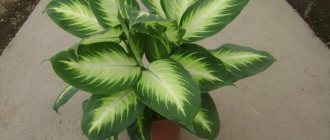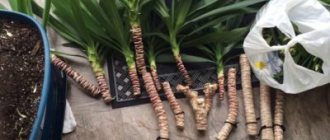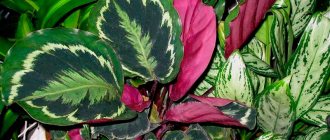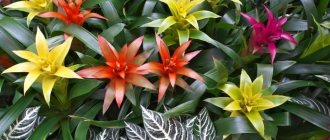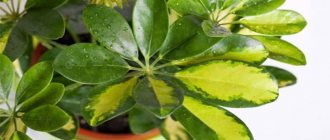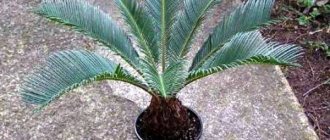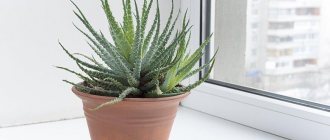Description and characteristics of the plant
Monstera belongs to indoor decorative vines. An adult plant can reach up to 5 m when grown in winter gardens or spacious rooms. But on average, the height of the vine is 1-1.5 m. The plant’s homeland is the tropical forests of South and Central America.
The main feature of Monstera is its large leaves of a bizarre dissected or perforated shape. Young leaves are usually round in shape without cuts. They acquire a bizarre shape as they grow. By the age of five, the leaves reach 50 centimeters in diameter. The stem of the plant is thick, the root system is powerful.
How to transplant a monstera
The small plant should be replanted every year. If the plant is 3-4 years old, then the replanting procedure is carried out once every two years, and a plant aged 5 years and older should be replanted once every 4 years. But you should add fresh substrate once a year. Slightly acidic and neutral soils, with the addition of humus and peat, are suitable for young plants. Older plants prefer soil with the addition of humus, sand, peat, deciduous soil and turf.
Mixtures for transplantation should be purchased ready-made or made independently. The plant should be planted in large pots, which must have good quality drainage.
Rules of care
Monstera is an unpretentious indoor plant that does not require much time. The main thing is to know the main characteristics of the plant in order to provide favorable conditions for the growth of the bush.
Illumination
Monstera is undemanding to light. It is better not to keep the plant in open sunlight at all, so that burns do not appear on the leaves. It is also not recommended to place pots in the shade. Young leaves will grow small, while older leaves will turn pale yellow. It is best to place the pot in partial shade so that the light is diffused. It is advisable to place pots on eastern or western windows.
Temperature
The plant prefers warmth; in cold rooms the bush grows poorly and often gets sick. The optimal temperature for the bush is +25-35 degrees in summer. In winter, the temperature can be reduced to +16 degrees. The main thing is to protect the bush from cold drafts.
Watering
Monstera is a moisture-loving plant. Since the plant’s homeland is the tropics, the bush needs to be watered often, and only with warm water. But monstera also does not tolerate excessive soil moisture. You can tell that a plant is experiencing excess moisture by looking at the droplets that appear at the tips of the leaves. In autumn, the soil is irrigated every two days, as soon as the top layer of soil begins to dry out. In winter, the amount of watering can be limited, especially if the apartment is cool. This can lead to rotting of the roots.
Spraying
Monstera loves spraying, especially in the summer, when the water quickly evaporates. Just like for irrigation, warm, settled water is used for spraying.
The leaves need to be wiped clean from dust regularly. The main thing is that after this there are no white stains left. In winter, it is not necessary to spray the bushes; you can only wipe the surface of the leaves with warm water.
See also
Step-by-step instructions for caring for orchids at home
Fertilizer
Monstera must be fertilized. If this procedure is neglected, the bushes grow poorly and the foliage takes on a pale green tint. The plant is fed in spring and summer. By autumn, fertilizers are applied as rarely as possible, and in winter they stop feeding completely. Monstera loves both root and foliar feeding. Fertilizers are applied at least twice a month. As fertilizers, you can use special complex fertilizers for representatives of the Araceae family. Fertilizers "Epin" or "Gumisol" are also suitable. For foliar feeding, “Urea-K6” is used.
Trimming
Monstera does not need pruning. You can trim off old, yellowing leaves.
Aerial roots and formation
You can trim it 1-2 times when the bush is still small, so that the plant is branched. But in this case, the monstera will need even more space. It is better not to touch the aerial roots at all; they are very fragile despite their impressive size.
Bloom
It is almost impossible to achieve flowering in indoor conditions. Monstera flowers are large and white. Outwardly they resemble a sail.
Transfer
Due to its fragile roots, Monstera does not tolerate transplantation well. It is best to plant the seedlings immediately in a large pot. But if this is not possible, young plants will have to be replanted 1-2 times a year. By 5-6 years the bush will be fully formed and there is no need to replant it. Only replace the top layer of soil.
Stands and supports
The bush needs good and strong support. Under natural conditions, trees serve as support for vines, so when growing indoors, you need to install a strong and thick beam in the center of the pot.
Features of winter care
In winter, the vine begins a dormant period. The amount of watering is reduced, and fertilizing is completely stopped until April.
Soil requirements and fertilization
The soil for monstera should be fertile and loose; it is advisable to add drainage to the bottom of the pot.
Composition of the substrate for planting a flower:
- turf land;
- peat;
- humus;
- river pebbles (can be replaced with coarse sand);
- crushed pine bark.
Fertilizing is applied to the soil from April to August.
Rest period
The dormant period of the vine begins in mid-October and lasts until April.
Caring for monstera at home. Briefly
| Temperature | In summer 20-25 degrees, not higher than 29 degrees; in winter 16-18 degrees, but not lower than 10 degrees. |
| Air humidity | Prefers high, but tolerates low. |
| Lighting | Monstera at home needs bright, diffused light. |
| Watering | In summer it is more abundant, in winter it is moderate. |
| Priming | Nutritious, retains moisture well. |
| Feeding and fertilizer | During the growing season, 2 times a month with fertilizers for deciduous plants. |
| Monstera transplant | Young specimens annually, adults - once every 3-5 years. |
| Reproduction | Cuttings, seeds, air layering. |
| Features of cultivation | Needs support; aerial roots are not cut off, but are directed into the ground. |
Reproduction methods
Monstera usually reproduces without problems. There are several ways to plant a plant. The longest growing method is seed. Most often, propagation is used by the tip of the stem, daughter shoots or cuttings.
From seeds
The seed method itself is simple. It is more difficult to find high-quality seeds from which you can grow healthy bushes. If you're lucky, a year after germination you can grow a good bush with 2-3 leaves.
The process of growing monstera from seeds:
- For planting, you can use light nutrient soil or moss.
- The temperature in the room should be constantly at the same level +23-+25 degrees, it is also important to provide the seedlings with diffused light.
- After planting, the seeds are covered with cling film or glass, which is removed regularly to ventilate the soil and water it.
Usually the seeds germinate 1-1.5 months after planting. When the bushes grow a little, they can be transplanted into separate pots in which they will grow all the time.
Cuttings
The easiest way is cuttings. To do this, cut a stem cutting with 2-3 leaves from the bush and place it in water. The cutting must be cut below the aerial root, from which roots then develop. The cuttings take root quickly; within two weeks the roots already have time to develop well.
See also
Rules for planting and caring for garden gerberas, features of cultivation
Top
Another method of propagation is from the top of the plant. The cut top is placed in water, which must be constantly changed so that it does not stagnate. When three developed roots appear, the monstera can be transplanted into pots.
Daughter processes
Monstera is propagated by daughter shoots in the spring. They appear at the bottom of the stem. Daughter shoots are planted immediately in pots.
How to propagate by apical and stem cuttings
The cutting is cut, of course, from the top of the flower. To facilitate the process, it is simply placed in water. After a few weeks, the cutting will take root.
Note! You need to wait until at least two roots appear, after which the plant can be planted in the soil.
Propagation by cuttings
For this method you will need a good piece of stem. The stem cutting must have two buds. To root it, you need a container of a suitable size with light peat soil, on which the cutting is simply placed with the bud down. There is no need to fill it up.
Next, the cutting is placed under a transparent glass or film cover, sometimes sprayed, moistened the soil, and ventilated. As the roots appear, the first leaf grows. After rooting, the flower can be planted in a permanent place.
Note! This type of plant propagation is considered more practical among experienced gardeners.
Possible problems
Problems when growing vines rarely arise. They are mainly associated with a deficiency or excess of nutrients in the soil and improperly organized watering.
Leaves fall
If you care for the monstera properly, no problems will arise. But it often happens that the leaves of the plant still fall off. The cause may be a lack of sunlight. If the vine is in the shade all the time, it will begin to lose its foliage. In this case, you can simply move the pot to the sun, to the west or east side.
Spots on the foliage
Spots on foliage are caused by spider mites. Spots can also occur due to lack of sunlight.
Yellowing of leaves
Foliage can turn yellow for various reasons:
- Overmoistening of the soil (in this case, the leaves also begin to rot).
- Lack of nutrients in the soil.
If the leaves become pale yellow and covered with yellow spots, this indicates an excess of sunlight.
Brown foliage
The foliage turns brown due to too dry air. The reason may also be that the plant is cramped in the pot. Or it may be that the soil is constantly waterlogged.
In this case, the leaves will not only turn brown, but also rot.
Pale color of young platinum leaves
Young leaves may turn pale due to lack of sunlight. It could also be due to a lack of nutrients.
The bush stretches out
The bush stretches out if it does not have enough sunlight. This usually happens if the vine stands in the shade all day. You can solve the problem if you place the pot in the sun for a while, and then move it to partial shade, where there will be diffused light.
Whole foliage
If the foliage is solid on young leaves, there is nothing terrible about it; divisions appear later. If the mature foliage is whole, this may indicate a lack of sunlight, low air temperature, or a lack of moisture or nutrients.
The foliage dries up and flies away
Old leaves usually fall off. If several leaves fall off at once and the top leaves turn brown, this may indicate that the room is too hot.
Disease and pest control
The main causes of diseases in monstera:
- Parasites;
- Insufficient or excessive lighting;
- Waterlogging of the soil;
- Cramped pot;
- Unfavorable air temperature.
If a plant begins to develop white spots on its leaves, the disease is most likely caused by too much light. A twisted stem and small leaves indicate a lack of light. In such cases, it is recommended to move the plant to another corner of the house.
The appearance of droplets on the leaves and wilting of the plant indicate an excess of moisture. In this situation, it is necessary to stop watering and let the soil dry out. Insufficient watering leads to leaves falling off and brown spots appearing on them. The problem can be solved by increasing the frequency of watering.
When pests appear, monstera leaves should be wiped with a cotton swab dipped in a soap solution. High humidity has a detrimental effect on parasites, so the plant should be sprayed more often. Spraying should be combined with a decrease in air temperature - the plant can be left under the air conditioner for a while. Monstera can be treated with a 0.2% rogor solution. If no method helps get rid of parasites, it is necessary to cut off the affected parts of the flower.
Harmful insects
Problems in growing vines can also arise due to the appearance of harmful insects.
Spider mite
Spraying with Actellik helps against spider mites. You also need to regularly ventilate the room and spray the vine with water.
Aphid
To treat vines against aphids, the preparations “Confidor”, “Fitoverm”, “Aktellik”, “Decis” are used. Treating with a solution of laundry soap also helps. You can quickly deal with aphids by spraying with garlic juice diluted in water or ground red pepper.
Shchitovka
You can often see scale insects on the plant. You can cope with it by spraying with garlic juice diluted in water. If there are few insects, they can be manually cleared from the leaves and the bush treated with Confidor or Decis. Repeat the procedure after 10 days.
See also
Rules for planting and caring for prickly pear cactus at home, methods of reproduction
Selection of location and conditions of detention
In order for the monstera not to lose the decorative appearance of its leaves and to please with flowering at least occasionally, it must be kept in conditions as close as possible to natural ones. Let's find out what they should be.
Lighting and location
Monstera loves good lighting, but direct rays of the sun are destructive for it. Therefore, it is best to place a container with a flower near east or west windows or in the back of the room if the room is well lit from all sides. In winter, additional lighting is important for the normal development of the plant, which will require the purchase of fluorescent lamps or special phytolamps.
Temperature
The optimal temperature for the development of monstera is +23…+25 °C in summer and +16…+18 °C in winter. Its decrease to 15 °C and below provokes growth cessation, and if it drops to +10 °C and below, the plant may become seriously ill or even die. But he is not afraid of sudden temperature changes.
Air and humidity
The air for monstera should be well humidified. Its humidity should be about 50-80%. If it is lower, then the leaves begin to dry out in places, forming unsightly yellow or brown spots. In this regard, the flower should not be placed near heat sources: they make the air too dry.
Monstera responds well to spraying the leaves with water and wiping them with a damp cloth to remove dust. But she doesn't like drafts. Therefore, it is better not to leave it in the open air: in nature, it is protected from the winds by neighboring plants: after all, it is a vine creeping upward along a support.
Soil and pot
A universal soil mixture, which can be purchased at a flower shop, is suitable for growing monstera. But you can prepare it yourself by mixing equal parts of dust-free river sand, high-moor peat, turf soil and humus.
Monstera is usually grown in plastic pots with drainage holes. The optimal diameter of the container is calculated as follows: add 4 cm to the width of the root system.
Kinds
There are several types of Monstera, the main differences relate to the appearance of the plant.
Delicatessen
The liana reaches about 12 m in length. The leaves are heart-shaped, elongated. After flowering, the Delicious Monstera produces fruits that are eaten. This type of vine is used for indoor landscaping.
Oblique
This variety is native to Brazil. A characteristic feature of this species is its perforated, ellipsoidal leaves. Towards the bottom they begin to narrow. The length of the leaves is from 20 to 25 cm. They are usually located asymmetrically on the stem.
Punched
The leaves are lopsided, asymmetrical, perforated. The leaves widen at the bottom. This species is native to South America.
Plant characteristics
The following is a brief description from which you can find out how the plant blooms, what size it is, as well as other information.
- Type: lianas.
- Flower/fruit color: white.
- Leaf color: green (sometimes with white accents).
- Sun requirement: diffused lighting.
- Size: more than 1 m.
- Flowering: rare.
- Aroma: weak.
Monstera is a beautiful large plant. But you need to be careful with it, since the juice of the culture can burn the mucous membranes. Therefore, when growing a plant, it is important to ensure that animals and children do not get it.
Toxicity and beneficial properties
The effect of monstera on the human body can hardly be called harmful. The only thing that can be noted is that there are microscopic needle-like formations on the leaves of Monstera. If they get on the mucous membrane, they can cause a burning sensation. But this can happen if pets or children chew the leaves. Otherwise, the plant is absolutely safe. This indoor plant does not cause significant harm to humans. Also, some gardeners are afraid to plant the plant, because the juice contains toxic substances, which can lead to poisoning.
But you can only be poisoned by monstera juice if you bite or eat a leaf.
Benefits of growing monstera:
- The plant enriches the air with oxygen and moisturizes it.
- Absorbs harmful substances.
- Thanks to the large leaves, the flower collects a lot of dust, which is then easy to get rid of by simply wiping them with soap and water.
- You can use the monstera to determine the weather. Before the rain, small drops appear on the leaves.
But the main advantage of the flower, which is why gardeners love it so much, is the decorative appearance of the plant. Monstera immediately enlivens the room and fits perfectly into any interior.
Frequently asked questions related to growing monstera
Is it possible to keep Monstera at home?
- Undoubtedly, this is a very beautiful indoor plant. However, it needs a spacious, bright room with a constant temperature.
Is Monstera poisonous?
- No, house monstera is safe for both people and pets. The only thing that can cause harm to health is its unripe fruits, which can cause inflammation of the mucous membranes. But, as already mentioned, monstera practically does not bear fruit in indoor conditions.
Why do monstera leaves wither?
- Wilting leaves may indicate disturbances in temperature, humidity, or pest infestation.
Why do the leaves dry out?
- Leaves dry out if the plant does not have enough feeding, watering or spraying, or if the room is too hot.
Why does the monstera “cry”?
- Droplets of transparent viscous liquid appear on monstera leaves on the eve of rain. This plant can be considered a natural barometer and can “predict” rain at least 24 hours in advance.
Rejuvenation and transplant rules
The rules for growing at home imply plant rejuvenation. The first sign is when an adult plant loses its decorative effect. Conducted in the spring. The top with 2-3 leaves is cut to 40 cm, the cut is treated with ash. In fact, such a cut is an apical cutting. After the procedure, the growth of lateral shoots is activated.
Replanting a vine is also easy: a few days before, the plant is well watered. Holding it by the trunk, carefully remove it from the container and shake off the substrate from the roots. Cut off dry and rotting ones, sprinkle the sections with ash. Pour boiling water over the new pot and drainage. Fill the pot up to 10 cm with drainage, then half with soil. Place the flower in the center, carefully straighten the roots. Add more soil, compact it easily and water generously.
